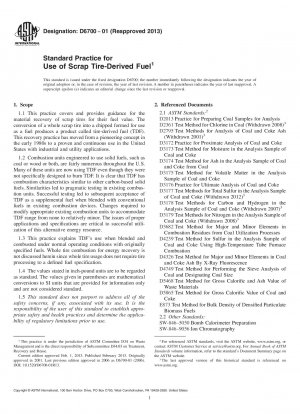ASTM D6700-01(2013)
Standard Practice for Use of Scrap Tire-Derived Fuel
- Standard No.
- ASTM D6700-01(2013)
- Release Date
- 2001
- Published By
- American Society for Testing and Materials (ASTM)
- Status
- Replace By
- ASTM D6700-19
- Latest
- ASTM D6700-19
- Scope
4.1 When considering the specification of fuels for a boiler, issues to evaluate are the fuel's combustion characteristics, handling and feeding logistics, environmental concerns, and ash residue considerations. A thorough understanding of these issues is required to engineer the combustion unit for power and steam generation; however, TDF has demonstrated compatible characteristics allowing it to serve as a supplemental fuel in existing combustion units based on cumulative experience in many facilities originally designed for traditional fossil fuels, or wood wastes, or both. When used as a supplemental energy resource in existing units, TDF usage is generally limited to blend ratios in the 10-30 % range based on energy input. This limit is due to its high heat release rate and low moisture content, which differ significantly from other solid fuels, such as wood, refuse derived fuel, coal and petroleum coke.
4.2 New combustion units dedicated to the use of TDF (or whole tires) as the sole fuel source are rare. The generation and availability of scrap tires is ultimately determined by market conditions for new tires and the depletion rate of scrap tire inventories (stockpiles). Scrap tires account for approximately 1 % of the municipal solid waste stream. Based on a national scrap tire generation rate, there are roughly 2.5 to 3 million tons (annually available for all uses to include fuel, crumb rubber, engineering projects, and so forth). Some dedicated combustion units have been built, however, competition for the scrap tires as other existing sources begin to use TDF will determine the ultimate viability of these facilities. Although most regions can supply TDF demand as a supplemental fuel, a dedicated boiler in the range of 500,000 lb/h (227,000 kg/h) steaming capacity would require over 668199;000 scrap tires/day to meet its fuel demand. Such demand may strain a region's ability to supply and put the fuel supply at risk. Some design projects have incorporated TDF as a supplemental fuel with wood, coal, coke, sludge, or some combination of multiple fuels where demand is consistent with supply availability.
4.3 It is important to understand what objectives may lead to TDF's choice as a supplemental fuel in existing power units. Several model objectives may be as follows:
4.4 Boilers generally are engineered around fuels that will be available through the amortized life of the power unit. Boiler design discussions here are limited as TDF standard size specifications have been developed to assure TDF's performance in existing systems. TDF is mined from the solid waste stream as a whole tire, then engineered via processing ......
ASTM D6700-01(2013) Referenced Document
- ASTM D2013 Standard Method of Preparing Coal Samples for Analysis
- ASTM D2361 Standard Test Method for Chlorine in Coal
- ASTM D2795 Standard Test Methods for Analysis of Coal and Coke Ash
- ASTM D3172 Standard Practice for Proximate Analysis of Coal and Coke
- ASTM D3173 Standard Test Method for Moisture in the Analysis Sample of Coal and Coke
- ASTM D3174 Standard Test Method for Ash in the Analysis Sample of Coal and Coke from Coal
- ASTM D3175 Standard Test Method for Volatile Matter in the Analysis Sample of Coal and Coke
- ASTM D3176 Standard Practice for Ultimate Analysis of Coal and Coke
- ASTM D3177 Standard Test Methods for Total Sulfur in the Analysis Sample of Coal and Coke
- ASTM D3178 Standard Test Methods for Carbon and Hydrogen in the Analysis Sample of Coal and Coke
- ASTM D3179 Standard Test Methods for Nitrogen in the Analysis Sample of Coal and Coke
- ASTM D3682 Standard Test Method for Major and Minor Elements in Combustion Residues from Coal Utilization Processes by Atomic Spectrometry
- ASTM D4239 Standard Test Methods for Sulfur in the Analysis Sample of Coal and Coke Using High Temperature Tube Furnace Combustion Methods
- ASTM D4326 Standard Test Method for Major and Minor Elements in Coal and Coke Ash By X-Ray Fluorescence
- ASTM D4749 Standard Test Method for Performing the Sieve Analysis of Coal and Designating Coal Size
- ASTM D5468 Standard Test Method for Gross Calorific and Ash Value of Waste Materials
- ASTM D5865 Standard Test Method for Gross Calorific Value of Coal and Coke
- ASTM E873 Standard Test Method for Bulk Density of Densified Particulate Biomass Fuels
ASTM D6700-01(2013) history
- 2019 ASTM D6700-19 Standard Guide for Use of Scrap Tires as Tire-Derived Fuel
- 2001 ASTM D6700-01(2013) Standard Practice for Use of Scrap Tire-Derived Fuel
- 2001 ASTM D6700-01(2006) Standard Practice for Use of Scrap Tire-Derived Fuel
- 2001 ASTM D6700-01 Standard Practice for Use of Scrap Tire-Derived Fuel

Copyright ©2024 All Rights Reserved